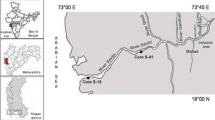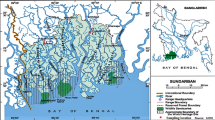Abstract
The 26 December 2004-tsunami has deposited sediments in the Pichavaram mangrove ecosystem, east coast of India. Ten surface and three core sediment samples were collected within 30 days of the event and analyzed for nutrients. Water samples were also analyzed to see the impact of tsunami on the geochemical behavior of nutrients. An increase in the concentration of various nutrients namely nitrate and phosphate was observed. The geochemistry of the mangrove forest was observed to be influenced by a number of factors like rapid increase of aquaculture farms, agricultural practices and the anthropogenic discharge from the nearby-inhabited areas. Further the sediment column was disturbed due to energetic tsunami waves, which has caused a sheer increase in the dissolved oxygen in water. As a result, the change in the redox potential has resulted in change in the nutrients absorbed/associated with the sediments. In addition, role of retreating water after tsunami on the nutrient geochemistry was also evaluated.




Similar content being viewed by others
References
Alongi DM (1988) Bacterial productivity and microbial biomass in tropical mangrove sediments. Microb Ecol 15:59–79
Alongi DM, Ramanathan AL, Kannan L, Tirendi F, Trott LA, Prasad MBK (2005) Human induced disturbance on benthic microbial metabolism in the Pichavaram mangroves, Vellar—Coleroon estuarine complex, India. Mar Biol 147:1033–1044
Alongi DM, Boto KG, Robertson AI (1992) Nitrogen and phosphorus cycles. In: Robertson AI, Alongi DM (eds) Tropical mangrove ecosystems. American Geophysical Union, Washington DC, pp 251–292
Anderson JM, Ingram JSI (1993) Tropical soil biology and fertility: a handbook of methods. CAB International, London, pp 171
APHA (1998) Standard methods for the examination of water and wastewater, 20th edn. American Public Health Association, Washington, DC
Bloodm ER, Anderson P, Smith PA, Nybro C, Ginsberg KA (1991) Effects of hurricane Hugo on coastal soil solution chemistry in South Carolina. Biotropica 23(4A):348–355
Boto KG, Wellington JT (1984) Soil characteristics and nutrients status in northern Australian mangrove forests. Estuaries 7:61–69
Boto KG (1982) Nutrient and organic fluxes in mangroves. In: Clough BF (ed) Mangrove ecosystems in Australia. ANU Press, Canberra, pp 239–257
Bryant E (2001) Tsunami the underrated hazard. Cambridge University Press, Cambridge, pp 320
Bryant E, Young R, Price D (1996) Tsunami as a major control of coastal evolution, southeastern Australia. J Coast Res 12:831–840
Bunt JS (1992) How can fragile ecosystems best be conserved? In: Hsü KJ, Thiede J (eds) Use and misuse of the seafloor (Dahlem workshop reports: environmental science research report 11). Wiley, Chichester, pp 229–242
Carman R, Aigars J, Larsen B (1996) Carbon and nutrient geochemistry of the surface sediments of the Gulf of Riga, Baltic Sea. Mar Geol 134(1–2):57–76
Danielsen F, Mikael K, Sørensen MF, Selvam V, Parish F, Burgess ND, Tetsuya H, Karunagaran VM, Rasmussen MS, Hansen LB, Quarto A, Suryadiputra N (2005) The Asian tsunami: a protective role for coastal vegetation. Science 310:643
Dawson A, Shi S (2000) Tsunami deposits. Pure Appl Geophys 157:875–897
Dawson AG (1994) Geomorphological effects of tsunami run-up and backwash. Geomorphology 10:83–94
Edwards GP, Molof AH, Schneeman RW (1965) Determination of orthophosphate in fresh and saline waters. J Am Water Works Assoc 57:917
Gelfenbaum G, Jaffe B (2003) Erosion and sedimentation from the 17 July 1998 Papua New Guinea tsunami. Pure Appl Geophys 160:1969–1999
Goldhaber MB, Kaplan IR (1974) The sulfur cycle. In: Goldberg ED (ed) The sea, marine chemistry 5: the sedimentary cycle. Wiley-Interscience, New York, pp 569–655
Griffiths JC (1967) Scientific methods in the analysis of sediments. McGraw-Hill, New York, pp 508
Hendricks SP, White DS (2000) Streams and groundwater influences on phosphorus biogeochemistry. In: Jones JB, Mulholland PJ (eds) Streams and groundwater. Academic Press, London, p 425
Ingram RL (1971) Sieve analysis. In: Carver RE (eds) Procedures in sedimentary petrology. Wiley-Interscience, New York, pp 49–94
Jackson ML (1973) Soil chemical analysis. Prentice Hall, New Delhi, pp 211–214
Kathiresan K, Rajendran N (2005) Coastal mangrove forests mitigated tsunami. Estuar Coast Shelf Sci 65:601–606
Kathiresan K (2005) Distribution of mangroves. In: Kathiresan K, Khan SA (eds) UNU-INWEH-UNESCO International Training Course on Coastal biodiversity in Mangrove Ecosystem—course manual. Annamalai University (CAS in Marine biology), Paringipettai, India, pp 410
Kathiresan K (2004) A review of studies on Pichavaram mangrove, southeast India. Hydrobioligia 30:185–205
Klekowski EJ, Lowenfeld RL, Hepler PK (1994) Mangrove genetics. II. Outcrossing and lower spontaneous mutation rates in Puerto Rican Rhizophora. Int J Plant Sci 155:373–381
Krishnamurthy K, Jeyaseelan MJP (1983) The Pitchavaram (India) mangrove ecosystem. Int J Ecol Environ Sci 9:79–85
Kristensen E, Andersen FO, Kofeod LH (1988) Preliminary assessment of benthic community metabolism in Southeast Asian mangrove swamp. Mar Ecol Prog Ser 48:137–145
Lindholm RC (1987) A practical approach to sedimentology. Allen and Unwin Inc, London, pp 276
Milliot G (1970) Geology of clays. Springer, New York, pp 429
Morell JM, Corredor JE (1993) Sediment nitrogen trapping in a mangrove lagoon. Estuar Coast Shelf Sci 37:203–212
Murphy J, Riley J (1962) A modified single solution method for determination of phosphate in natural waters. Anal Chim Acta 27:31
Nagaraja P, Kumar MH, Yathirajan H, Prakash J (2003) Highly selective reaction of nitrate with brucine and 3-methyl-2-benzothiazolinone hydrazone hydrochloride for determination of nitrate in environmental samples. Anal Sci 19:961–963
Nanayama F, Satake K, Shimokawa K, Furukawa R, Shigeno K (2000) Evaluation of frequency and invasion area of large earthquake tsunamis along the Kurile subduction zone by postulated tsunami deposits. In: Sugiyama Y (ed) Interim report on active fault and paleoearthequake research in the 1999 fiscal year. Geological Survey of Japan Interim Report # EQ/00/2, Geological Survey of Japan, Tsukuba, pp 1–17
Nishimura Y, Miyaji N (1995) Tsunami deposits from the 1993 Southwest Hokkaido earthquake and the 1640 Hokkaido Komagatake eruption, Northern Japan, tsunamis: 1992–1994. Their generation, dynamics and hazard. In: Satake S, Imamura F (eds) Pageoph topical volumes. Birkhauser Verlag, vol 144, 3/4, pp 719–733
Prasad MBK (2005) Nutrient dynamics in Pichavaram Mangroves, South east Coast of India. PhD, Jawaharlal Nehru University, New Delhi, India (in English)
Presley BJ (1971) Appendix: techniques for analyzing interstitial water samples. Part I: determination of selected minor and major inorganic constituents. In Winterer EL et al (eds) Initial reports of the deep sea drilling project. US Government Printing Office, Washington, vol VII, pp 1749–1755
Purvaja R, Ramesh R (2000) Human impacts on methane emission from mangrove ecosystems in India. Reg Environ Change 1:86–97
Ramanathan AL, Subramanian V, Ramesh R, Chidambaram S, James A (1999) Environmental geochemistry of the Pichavaram mangrove ecosystem (tropical), Southeast coast of India. Environ Geol 37(3):223–233
Ramanathan AL, Vaidhyanathan P, Subramanian V, Das BK (1993) Geochemistry of the Cauvery estuary, east coast of India. Estuaries 16:459–474
Ramanathan AL (1997) Sediment characteristics of the Pichavaram mangrove environment, Southeast coast of India. Indian J Mar Sci 26:319–322
Ramesh R, Kumar RA, Inamdar AB, Mohan PM, Prithviraj M, Ramachandran S (2006) Tsunami characterization and mapping in Andaman and Nicobar Islands. In: Rajamanickam GV (ed) 26th December 2004, Tsunami: causes, effects, remedial measures, pre and post tsunami disaster management, a geoscientific perspective. Department of Science and Technology report, New Delhi, pp 150–174
Ranjan RK (2006) Impact of tsunami on the biogeochemical changes in sediments of Pichavaram mangroves, South east coast of India—post tsunami scenario. M.Phil, Jawaharlal Nehru University, New Delhi, India (in English)
Scheffers A, Kelletat D (2003) Sedeimentologic and geomorphic tsunami imprints worldwide—a review. Earth Sci Rev 63:83–92
Seralathan P, Srinivasalu S, Ramanathan AL, Rajamanickam GV, Nagendra R, Singarasubramanian SR, Mukesh MV, Manoharan K (2006) Post tsunami sediments characteristics of Tamilnadu Coast. In: Rajamanickam GV (ed) 26th December 2004 Tsunami causes, effects remedial measures, pre and post tsunami disaster management, a geoscientific perspective. Department of Science and Technology report, New Delhi, pp 196–209
Shapiro L (1975) Rapid analysis of silicate, carbonate and phosphate rocks, revised edition. USGS Bull 1401:1–54
Singh G, Ramanathan AL, Prasad MBK (2005) Nutrient cycling in Mangrove ecosystem: a brief overview. J Ecol Environ Sci 30(3):231–244
Solorzano L (1969) Determination of ammonia in natural waters by the phenolhypochlorite method. Limnol Oceanogr 14:799–801
Subramanian AN (2004) Status of Indian mangroves: pollution status of the Pichavaram mangrove area, south-east coast of India. In: Vannucci M (ed) Mangrove management and conservation. United Nations University Press, Tokyo, pp 59–75
Szczuciński W, Niedzielski P, Rachlewicz G, Sobczyński T, Zioła A, Kowalski A, Lorenc S, Siepak J (2005) Contamination of tsunami sediments in a coastal zone inundated by the 26 December 2004 tsunami in Thailand. Environ Geol 49:321–31
Tandon HLS (1987) Phosphorus research and agricultural production in India. Fertilizer Development and Consultant Organization, Government of India, New Delhi, pp 160
Yeon Cho Hong, Lakshumanan C, Natesan U (2004) Coastal wetland and shoreline change mapping of Pichavaram, south east coast of India using Satellite data. Map India Conference 2004, Beijing, China
Acknowledgment
The authors acknowledge the Ministry of Forest, Govt of Tamil Nadu for providing permission for sampling as well as Jawaharlal Nehru University for providing necessary facilities to carry out this work. One of the authors (RKR) acknowledges Sat Paul Mittal Trust for providing assistance in the form of scholarship. IFS, FORMAS, Sweden’s (to ALR) partial support to this work is greatly appreciated.
Author information
Authors and Affiliations
Corresponding author
Rights and permissions
About this article
Cite this article
Ranjan, R.K., Ramanathan, A. & Singh, G. Evaluation of geochemical impact of tsunami on Pichavaram mangrove ecosystem, southeast coast of India. Environ Geol 55, 687–697 (2008). https://doi.org/10.1007/s00254-007-1019-9
Received:
Accepted:
Published:
Issue Date:
DOI: https://doi.org/10.1007/s00254-007-1019-9




